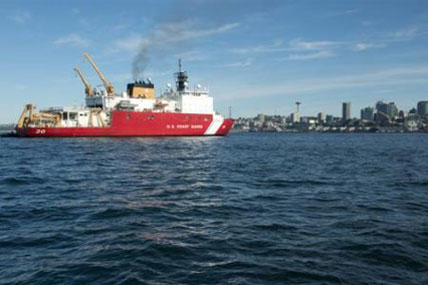SEATTLE – After completing 130 days of operations in the Bering Sea, Chukchi Sea, and Arctic Ocean, the Coast Guard Cutter Healy will moor in Seattle Thursday, Sept. 11.
During the past four months, Healy conducted three missions to further scientific knowledge and understanding of the Arctic.
The first mission, the Study of Under Ice Blooms in the Chukchi Ecosystem, was led by Stanford University personnel with funding from the National Science Foundation. This mission utilized a variety of tools and equipment to investigate, sample and collect information. Scientists worked with a conductivity, temperature and depth rosette, plankton and zooplankton nets, vanveen grabs, a light-frame onsite keyspecies investigative imaging device, a trace metal detection FISH that was towed alongside the ship, a trace metal pump and weather balloons. The compilation of each of these individual components enabled a vast amount of scientific data about the Chukchi ecosystem to be woven together for education and understanding of ongoing biological, physical, and chemical oceanographic and other related trends in the Arctic. Throughout this phase Healy’s crew completed 230 science station evolutions in which the ship stopped to conduct operations, including 14 on-ice deployments.
The second scientific mission of the summer was completed by Woods Hole Oceanographic Institution scientists who were studying the Pacific Boundary Current and other oceanographic trends in the Arctic. The study of these currents and data collection was captured utilizing sub-surface oceanographic moorings. The moorings remain onsite for one to two years and capture a year-long dataset of what is occurring on the continental shelf off the north coast of Alaska. The information collected by the moorings, along with data captured by 156 CTD rosette casts, allow for the continuation of research that has been supported by Healy over the last 10 years.
The third and final science pursuit of the summer was accomplished with a team from the Coast Guard’s Research and Development Center. Members from the center brought technologies and equipment to be utilized for oil spill monitoring in the harsh Arctic environment. Tools used to complete mission objectives and testing evaluation consisted of several remotely operated vehicles, a few small unmanned aerial systems, an autonomous underwater vehicle, an unmanned surface vehicle, surface wave instrument float with tracking buoys, oil spill tracking buoys, and an aerostat balloon. Other smaller materials and projects were evaluated for use by the Coast Guard in the Arctic, and all of these tests together yielded a greater understanding of tools to available to respond to an oil spill should an accident occur in the ice at extreme northern latitudes.
Healy, delivered in 1999, is the nation’s newest and largest U.S. high latitude icebreaker. The cutter is 420-feet long and has extensive scientific capabilities. Based out of Seattle, the cutter has a permanent crew of 87; its primary mission is scientific support. In addition, as a Coast Guard cutter, Healy is capable of other operations such as search and rescue, ship escorts, environmental protection, and the enforcement of laws and treaties in the Polar Regions.





























